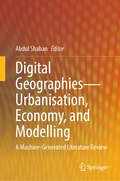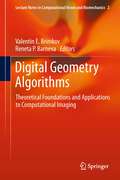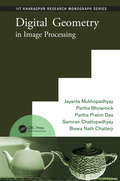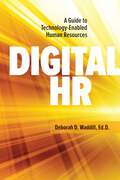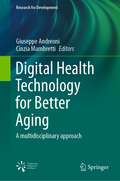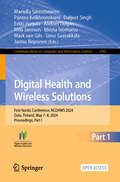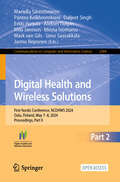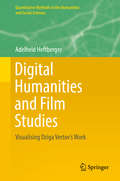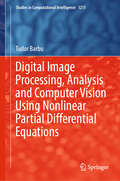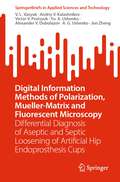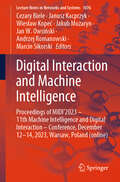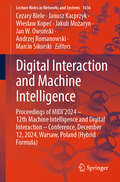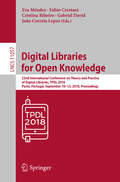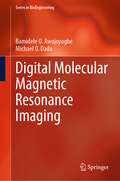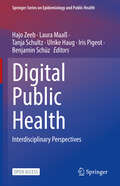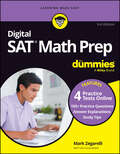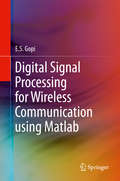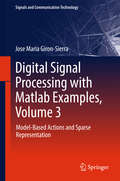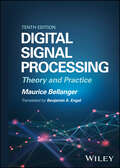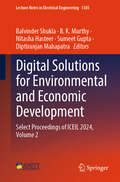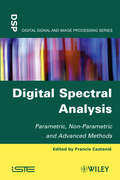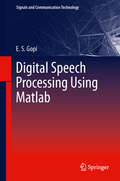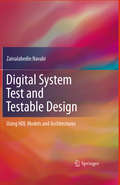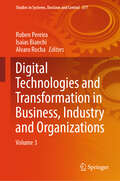- Table View
- List View
Digital Geographies—Urbanisation, Economy, and Modelling: A Machine-Generated Literature Review
by Abdul ShabanThis machine-generated volume, with chapter introductions by the human expert, of summaries of the existing studies furthers our understanding of the impact of digitalisation on spaces, their imaginations and representations. It brings out the digital territorial and socio-economic digital modelling and representation methods. The virtual spaces, created by GIS, photoshopping, games, etc., have become an area of interest for many as they produce spatial imaginaries having social, political and individual consequences. It delves into the literature on digital capitalism and how it is giving birth to a new mode of expansionary capitalism to reap the surplus values and profits from peripheries and drain the same to the core. It shows how digitalisation has enabled enterprises to operate from a virtual space with strong spatial networks. Mega digital enterprises together control a trillion-dollar economy having massive consequences for digital labour, welfare of consumers, and development geographies. This book explores some critical questions while generating summaries of existing literature: How do imaginaries, models or virtual realities help us comprehend spatialities? How does capitalism relate to digitalism, and with what consequences? How do the cities and mobilities relate to digitalisation? What are the possibilities of re-configuring the man-environmental relations with digital technologies in view of rising pollution and impending climate change? Teachers, researchers, and students engaged in this new area of digital geography, especially in social science and its subfields of sociology, economics, political sciences, anthropology, psychology, development studies, policy studies, social work, urban studies, and planning, will find the volume very useful. For a full picture, the book can be read in combination with its companion volume on ‘Digital Geographies – Theory, Space and Communities’.
Digital Geometry Algorithms
by Reneta P. Barneva Valentin E. BrimkovDigital geometry emerged as an independent discipline in the second half of the last century. It deals with geometric properties of digital objects and is developed with the unambiguous goal to provide rigorous theoretical foundations for devising new advanced approaches and algorithms for various problems of visual computing. Different aspects of digital geometry have been addressed in the literature. This book is the first one that explicitly focuses on the presentation of the most important digital geometry algorithms. Each chapter provides a brief survey on a major research area related to the general volume theme, description and analysis of related fundamental algorithms, as well as new original contributions by the authors. Every chapter contains a section in which interesting open problems are addressed.
Digital Geometry in Image Processing
by Samiran Chattopadhyay Jayanta Mukhopadhyay Partha Pratim Das Partha Bhowmick Biswa Nath ChatterjiExploring theories and applications developed during the last 30 years, Digital Geometry in Image Processing presents a mathematical treatment of the properties of digital metric spaces and their relevance in analyzing shapes in two and three dimensions. Unlike similar books, this one connects the two areas of image processing and digital geometry,
Digital HR: A Guide to Technology-Enabled Human Resources
by Deborah WaddillIt's an exciting time to be in HR as scores of technologies including AI, predictive modeling, real-time data analytics, HR shared service centers and others are being implemented at a rapid pace by HR leaders around the world every day.Digital HR expertly addresses the revolutionary trends and disruptive technologies to provide HR executives, managers, specialists, generalists and students with a comprehensive and evidence-based guide to current technologies that enhance, enable, revitalize and empower Human Resources. With practical insight, real-world case studies, tips and tools, recommendations and additional resources, the author guides readers through each of the major technologies and addresses vital strategic and implementation issues.Designed for HR professionals and students at all levels, the book explores how these tools can enhance decision-making, streamline operations and create more agile, strategic HR functions.
Digital Health Technology for Better Aging: A multidisciplinary approach (Research for Development)
by Giuseppe Andreoni Cinzia MambrettiThis book describes the multidisciplinary approach needed to tackle better aging. Aging populations are one of the 21st century’s biggest challenges. National health systems are forced to adapt in order to provide adequate and affordable care. Innovation, driven by digital technology, is a key to improving quality of life and encouraging healthy living. Well-designed technology keeps people empowered, independent, and mobile; however, despite widespread adoption of ICT in day-to-day life, digital health technologies have yet to catch on. To this end, technology needs to be effective, usable, cheap, and designed to ensure the security of the managed data. In the era of mHealth, mobile technology, and social design, this book describes, in six sections, the collaboration of polytechnic know-how and social science and health sectors in the creation of a system for encouraging people to engage in healthy behavior and achieve a better quality of life.
Digital Health and Wireless Solutions: First Nordic Conference, NCDHWS 2024, Oulu, Finland, May 7–8, 2024, Proceedings, Part I (Communications in Computer and Information Science #2083)
by Daljeet Singh Miia Jansson Mariella Särestöniemi Pantea Keikhosrokiani Erkki Harjula Aleksei Tiulpin Minna Isomursu Mark Van Gils Simo Saarakkala Jarmo ReponenThis two-volume set constitutes the refereed proceedings of the First Nordic Conference on , Digital Health and Wireless Solutions, NCDHWS 2024, held in Oulu, Finland, during May 7–8, 2024. The 51 full papers included in this book together with 7 short papers were carefully reviewed and selected from 100 submissions. They were organized in topical sections as follows: Part I: Remote Care and Health Connectivity Architectures in 6G Era.- User Experience and Citizen Data.- Digitalization in Health Education.- Digital Health Innovations.- Digital Care Pathways. Part II: Clinical Decision Support and Medical AI.- Digital Care Pathways.- Novel Sensors and Bioinformatics.- Health Technology Assessment and Impact Evaluation.- Wireless Technologies and Medical Devices. This book is open access.
Digital Health and Wireless Solutions: First Nordic Conference, NCDHWS 2024, Oulu, Finland, May 7–8, 2024, Proceedings, Part II (Communications in Computer and Information Science #2084)
by Daljeet Singh Miia Jansson Mariella Särestöniemi Pantea Keikhosrokiani Erkki Harjula Aleksei Tiulpin Minna Isomursu Mark Van Gils Simo Saarakkala Jarmo ReponenThis two-volume set constitutes the refereed proceedings of the First Nordic Conference on , Digital Health and Wireless Solutions, NCDHWS 2024, held in Oulu, Finland, during May 7–8, 2024. The 51 full papers included in this book together with 7 short papers were carefully reviewed and selected from 100 submissions. They were organized in topical sections as follows: Part I: Remote Care and Health Connectivity Architectures in 6G Era.- User Experience and Citizen Data.- Digitalization in Health Education.- Digital Health Innovations.- Digital Care Pathways. Part II: Clinical Decision Support and Medical AI.- Digital Care Pathways.- Novel Sensors and Bioinformatics.- Health Technology Assessment and Impact Evaluation.- Wireless Technologies and Medical Devices. This book is open access.
Digital Humanities and Film Studies: Visualising Dziga Vertov's Work (Quantitative Methods in the Humanities and Social Sciences)
by Adelheid HeftbergerThis book highlights the quantitative methods of data mining and information visualization and explores their use in relation to the films and writings of the Russian director, Dziga Vertov. The theoretical basis of the work harkens back to the time when a group of Russian artists and scholars, known as the “formalists,” developed new concepts of how art could be studied and measured. This book brings those ideas to the digital age. One of the central questions the book intends to address is, “How can hypothetical notions in film studies be supported or falsified using empirical data and statistical tools?” The first stage involves manual and computer-assisted annotation of the films, leading to the production of empirical data which is then used for statistical analysis but more importantly for the development of visualizations. Studies of this type furthermore shed light on the field of visual presentation of time-based processes; an area which has its origin in the Russian formalist sphere of the 1920s and which has recently gained new relevance due to technological advances and new possibilities for computer-assisted analysis of large and complex data sets. In order to reach a profound understanding of Vertov and his films, the manual or computer-assisted data analysis must be combined with film-historical knowledge and a study of primary sources. In addition, the status of the surviving film materials and the precise analysis of these materials combined with knowledge of historical film technology provide insight into archival policy and political culture in the Soviet Union in the 1920s and 30s.
Digital Image Processing, Analysis and Computer Vision Using Nonlinear Partial Differential Equations (Studies in Computational Intelligence #1211)
by Tudor BarbuThis book provides an overview of the applications of partial differential equations (PDEs) to image processing, analysis, and computer vision domains, focusing mainly on the most important contributions of the author in these closely related fields. It addresses almost all the PDE-based image processing and analysis areas, and the connections between partial differential equations, computer vision, and artificial intelligence: PDE-based image filtering, inpainting, compression, segmentation, content-based recognition, indexing and retrieval, and video object detection and tracking, energy-based (variational) and nonlinear diffusion-based models of second and fourth order, nonlinear PDE-based scale-spaces in combination to convolutional neural networks and high-level descriptors to perform edge and feature extraction.
Digital Image Processing: An Algorithmic Approach with MATLAB (Chapman & Hall/CRC Textbooks in Computing)
by Uvais Qidwai C.H. ChenAvoiding heavy mathematics and lengthy programming details, Digital Image Processing: An Algorithmic Approach with MATLAB presents an easy methodology for learning the fundamentals of image processing. The book applies the algorithms using MATLAB, without bogging down students with syntactical and debugging issues.One chapter can typically be compl
Digital Information Methods of Polarization, Mueller-Matrix and Fluorescent Microscopy: Differential Diagnosis of Aseptic and Septic Loosening of Artificial Hip Endoprosthesis Cups (SpringerBriefs in Applied Sciences and Technology)
by Jun Zheng A. G. Ushenko Yu. A. Ushenko Alexander V. Dubolazov V. L. Vasyuk Andriy V. Kalashnikov Victor V. ProtsyukThis book highlights the effectiveness of differential diagnosis in the degree of severity of joint pathology from a clinical, biophysical, and informational point of view. It includes the following information blocks: • Two-dimensional digital polarization microscopy of polycrystalline films of synovial fluid and determination of the coordinate distributions of the orientation and phase parameters of the microscopic image from a set of parameters of the Stokes vector. • Mueller-matrix mapping of polycrystalline films of synovial fluid and determination of a set of coordinate distributions (Mueller-matrix images (MMI)) of azimuthal-invariant elements that characterize manifestations of optical activity and linear birefringence. • Development of algorithms for polarization reproduction of distributions of linear and circular birefringence of polycrystalline films of synovial fluid. • Identification of digital statistical, correlation and wavelet criteria of polarization and Mueller-matrix differential diagnosis of the degree of severity of joint pathology. • Determination of maps of laser-induced fluorescence of synovial fluid polycrystalline films. • Identification of statistical and correlational criteria for fluorescent differential diagnosis of the degree of severity of joint pathology. • Operational characteristics of the power of the methods of azimuth-invariant polarization, Mueller-matrix and laser autofluorescence microscopy of polycrystalline films of synovial fluid.
Digital Interaction and Machine Intelligence: Proceedings of MIDI’2023 – 11th Machine Intelligence and Digital Interaction – Conference, December 12-14, 2023, Warsaw, Poland (online) (Lecture Notes in Networks and Systems #1076)
by Janusz Kacprzyk Jan W. Owsiński Cezary Biele Andrzej Romanowski Marcin Sikorski Wiesław Kopeć Jakub MożarynArtificial intelligence (AI) is revolutionizing our daily lives, thanks to remarkable advancements in research and the widespread adoption of interactive technologies. This transformation has ushered in a wave of new social phenomena, prompting nations worldwide to seek understanding and solutions. These efforts necessitate multidisciplinary approaches, encompassing not only the scientific fields involved in the creation of artificial intelligence and human–computer interaction but also strong collaboration between academics and practitioners, discovering more in the MIDI conference proceedings book, and featuring the latest insights from the conference held online on December 12–14, 2023 that combine two up until recently distinct disciplines of research—artificial intelligence and human–technology interaction.
Digital Interaction and Machine Intelligence: Proceedings of MIDI’2024 – 12th Machine Intelligence and Digital Interaction – Conference, December 12, 2024, Warsaw, Poland (Hybrid Formula) (Lecture Notes in Networks and Systems #1636)
by Janusz Kacprzyk Jan W. Owsiński Cezary Biele Andrzej Romanowski Marcin Sikorski Wiesław Kopeć Jakub MożarynThis book presents the Proceedings of the 12th Machine Intelligence and Digital Interaction Conference, and it combines two disciplines of research. The rapid progress in artificial intelligence research and the widespread use of interactive technologies are fundamentally changing our daily lives. This has given rise to new social dynamics, compelling nations around the world to develop new insights and strategies. Addressing these changes effectively demands a multidisciplinary strategy, uniting experts from AI and human-computer interaction with both academic researchers and industry practitioners. The proceedings from the 2024 MIDI conference offer the latest research on the convergence of these two formerly separate fields.
Digital Libraries for Open Knowledge: 22nd International Conference on Theory and Practice of Digital Libraries, TPDL 2018, Porto, Portugal, September 10–13, 2018, Proceedings (Lecture Notes in Computer Science #11057)
by Fabio Crestani Eva Méndez Cristina Ribeiro Gabriel David João Correia LopesThis book constitutes the proceedings of the 22nd International Conference on Theory and Practice of Digital Libraries, TPDL 2018, held in Porto, Portugal, in September 2018. The 51 full papers, 17 short papers, and 13 poster and tutorial papers presented in this volume were carefully reviewed and selected from 81 submissions. The general theme of TPDL 2018 was Digital Libraries for Open Knowledge. The papers present a wide range of the following topics: Metadata, Entity Disambiguation, Data Management, Scholarly Communication, Digital Humanities, User Interaction, Resources, Information Extraction, Information Retrieval, Recommendation.
Digital Molecular Magnetic Resonance Imaging (Series in BioEngineering)
by Michael O. Dada Bamidele O. AwojoyogbeThis book pushes the limits of conventional MRI visualization methods by completely changing the medical imaging landscape and leads to innovations that will help patients and healthcare providers alike. It enhances the capabilities of MRI anatomical visualization to a level that has never before been possible for researchers and clinicians. The computational and digital algorithms developed can enable a more thorough understanding of the intricate structures found within the human body, surpassing the constraints of traditional 2D methods. The Physics-informed Neural Networks as presented can enhance three-dimensional rendering for deeper understanding of the spatial relationships and subtle abnormalities of anatomical features and sets the stage for upcoming advancements that could impact a wider range of digital heath modalities. This book opens the door to ultra-powerful digital molecular MRI powered by quantum computing that can perform calculations that would take supercomputers millions of years.
Digital Public Health: Interdisciplinary Perspectives (Springer Series on Epidemiology and Public Health)
by Iris Pigeot Tanja Schultz Hajo Zeeb Laura Maaß Ulrike Haug Benjamin SchüzThis comprehensive open access book gives an overview of the core issues in digital public health, with a strong emphasis on prevention, population health, and health systems. It covers a broad spectrum of topics, ranging from theoretical frameworks to legal and ethical issues related to digital public health applications and interventions. With chapters on user-centered technology development, evaluation, participatory approaches in digital public health, and global digital public perspectives, it also presents examples taken from ten essential public health operations. Targeted at researchers in academia, industry, and government, this unique text offers a broad insight into digitalization, a central topic in the current development of public health worldwide.
Digital SAT Math Prep For Dummies, 3rd Edition: Book + 4 Practice Tests Online, Updated for the NEW Digital Format
by Mark ZegarelliHone your math skills to score well on the SAT Digital SAT Math Prep For Dummies is a jam-packed study guide to the section of the SAT students struggle with most. This update covers major changes to the test as the SAT goes fully digital in spring 2024. With this book, you can improve your score with proven test-taking strategies and four practice exams. Drill down on the concepts you need help with the most, and prepare to breeze through all 44 questions on test day. Learn exactly what will be on the new, all-digital SAT math section Get tips for solving problems quicker and making good guesses when you need to Practice, practice, practice, with 4 tests Maximize your score—and your chances of getting into your top-choice colleges If you’re a high school student preparing to take the SAT and you need to designate extra study time to developing your math skills, this book is for you.
Digital Signal Processing for Wireless Communication using Matlab
by E. S. GopiThis book examines signal processing techniques used in wireless communication illustrated by using the Matlab program. The author discusses these techniques as they relate to Doppler spread, Delay spread, Rayleigh and Rician channel modeling, rake receiver, diversity techniques, MIMO and OFDM based transmission techniques, and array signal processing. Related topics such as detection theory, Link budget, Multiple access techniques, spread spectrum, are also covered. * Illustrates signal processing techniques involved in wireless communication * Discusses multiple access techniques such as Frequency division multiple access, Time division multiple access, and Code division multiple access * Covers band pass modulation techniques such as Binary phase shift keying, Differential phase shift keying, Quadrature phase shift keying, Binary frequency shift keying, Minimum shift keying, and Gaussian minimum shift keying.
Digital Signal Processing with Matlab Examples, Volume 3
by Jose Maria Giron-SierraThis is the third volume in a trilogy on modern Signal Processing. The three books provide a concise exposition of signal processing topics, and a guide to support individual practical exploration based on MATLAB programs. This book includes MATLAB codes to illustrate each of the main steps of the theory, offering a self-contained guide suitable for independent study. The code is embedded in the text, helping readers to put into practice the ideas and methods discussed. The book primarily focuses on filter banks, wavelets, and images. While the Fourier transform is adequate for periodic signals, wavelets are more suitable for other cases, such as short-duration signals: bursts, spikes, tweets, lung sounds, etc. Both Fourier and wavelet transforms decompose signals into components. Further, both are also invertible, so the original signals can be recovered from their components. Compressed sensing has emerged as a promising idea. One of the intended applications is networked devices or sensors, which are now becoming a reality; accordingly, this topic is also addressed. A selection of experiments that demonstrate image denoising applications are also included. In the interest of reader-friendliness, the longer programs have been grouped in an appendix; further, a second appendix on optimization has been added to supplement the content of the last chapter.
Digital Signal Processing: Theory and Practice
by Maurice BellangerDIGITAL SIGNAL PROCESSING Understand the future of signal processing with the latest edition of this groundbreaking text Signal processing is a key aspect of virtually all engineering fields. Digital techniques enormously expand the possible applications of signal processing, forming a part of not only conventional engineering projects but also data analysis and artificial intelligence. There are considerable challenges raised by these techniques, however, as the gulf between theory and practice can be wide; the successful integration of digital signal processing techniques requires engineers capable of bridging this gulf. For years, Digital Signal Processing has met this need with a comprehensive guide that consistently connects abstract theory with practical applications. Now fully updated to reflect the most recent developments in this crucial field, the tenth* edition of this seminal text promises to foster a broader understanding of signal processing among a new generation of engineers and researchers. Readers of the new edition of Digital Signal Processing will also find: Exercises at the end of each chapter to reinforce key conceptsA new chapter covering digital signal processing for neural networksHandy structure beginning with undergraduate-level material before moving to more advanced concepts in the second half Digital Signal Processing is a must-own for students, researchers, and industry professionals in any of the hundreds of fields and subfields that make use of signal processing algorithms. *This is the English language translation of the French original Traitement Numérique du Signal 10th edition by Maurice Bellanger © Dunod 2022 and is the 4th edition in English.
Digital Solutions for Environmental and Economic Development: Select Proceedings of ICEIL 2024, Volume 2 (Lecture Notes in Electrical Engineering #1385)
by Sumeet Gupta Balvinder Shukla B. K. Murthy Nitasha Hasteer Diptiranjan MahapatraThe proceedings of 6th International Conference on Entrepreneurship Innovation and Leadership (ICEIL 2024) would focus on Intelligent IT Solutions to promote indigenous innovations. The book will be a catalyst for transformative change, inspiring a collective effort towards harnessing the power of technology for sustainable, self-reliant development. This book will be a compilation of latest technological advancements and state of the art research in the emerging technologies like artificial intelligence, blockchain, internet of things, quantum computing etc. This book will be useful for students, research scholars and practitioners from different disciplines to enhance their knowledge.
Digital Spectral Analysis: Parametric, Non-Parametric and Advanced Methods (Wiley-iste Ser.)
by Francis CastaniéDigital Spectral Analysis provides a single source that offers complete coverage of the spectral analysis domain. This self-contained work includes details on advanced topics that are usually presented in scattered sources throughout the literature. The theoretical principles necessary for the understanding of spectral analysis are discussed in the first four chapters: fundamentals, digital signal processing, estimation in spectral analysis, and time-series models. An entire chapter is devoted to the non-parametric methods most widely used in industry. High resolution methods are detailed in a further four chapters: spectral analysis by stationary time series modeling, minimum variance, and subspace-based estimators. Finally, advanced concepts are the core of the last four chapters: spectral analysis of non-stationary random signals, space time adaptive processing: irregularly sampled data processing, particle filtering and tracking of varying sinusoids. Suitable for students, engineers working in industry, and academics at any level, this book provides a rare complete overview of the spectral analysis domain.
Digital Speech Processing Using Matlab
by E. S. GopiDigital Speech Processing Using Matlab deals with digital speech pattern recognition, speech production model, speech feature extraction, and speech compression. The book is written in a manner that is suitable for beginners pursuing basic research in digital speech processing. Matlab illustrations are provided for most topics to enable better understanding of concepts. This book also deals with the basic pattern recognition techniques (illustrated with speech signals using Matlab) such as PCA, LDA, ICA, SVM, HMM, GMM, BPN, and KSOM.
Digital System Test and Testable Design
by Zainalabedin NavabiThis book is about digital system testing and testable design. The concepts of testing and testability are treated together with digital design practices and methodologies. The book uses Verilog models and testbenches for implementing and explaining fault simulation and test generation algorithms. Extensive use of Verilog and Verilog PLI for test applications is what distinguishes this book from other test and testability books. Verilog eliminates ambiguities in test algorithms and BIST and DFT hardware architectures, and it clearly describes the architecture of the testability hardware and its test sessions. Describing many of the on-chip decompression algorithms in Verilog helps to evaluate these algorithms in terms of hardware overhead and timing, and thus feasibility of using them for System-on-Chip designs. Extensive use of testbenches and testbench development techniques is another unique feature of this book. Using PLI in developing testbenches and virtual testers provides a powerful programming tool, interfaced with hardware described in Verilog. This mixed hardware/software environment facilitates description of complex test programs and test strategies.
Digital Technologies and Transformation in Business, Industry and Organizations: Volume 3 (Studies in Systems, Decision and Control #577)
by Alvaro Rocha Ruben Pereira Isaias BianchiThis book covers research methods such as Systematic Literature Review (SLR) or Multifocal Literature Review (MLR), case studies, experiments, surveys, and Design Science Research using quantitative and qualitative approaches. This proposal is the third volume of the already edited and published book “Digital Technologies and Transformation in Business, Industry and Organizations.” Given the nature of this book proposal, linked with some Masters, and the faster pace of digital technologies evolution, the new version will have an entire new content with new cases and insights regarding the development and implementation of the most interesting digital technologies. Digital transformation marks a rethinking of how an organization uses technology, people, and processes in pursuit of new business models and new revenue streams, driven by changes in customer expectations around products and services. For many enterprises that build traditional goods, this means building digital products, such as a mobile application or an e-commerce platform. To do so, they must use and integrate digital technologies. The pace of change is increasing. Organizations need to adapt or risk disappearing under innovators entrance in the market. With new digital technologies growing in an exponential rate in the last few decades, organizations are facing even more complex contexts. Managers are now pressed to take efficient decisions. This book provides a reference manual to assist professionals and academics on further insights regarding: the impact of digital technologies in business, how to implement digital technologies, solutions for specific digital technologies barriers, and much more.
